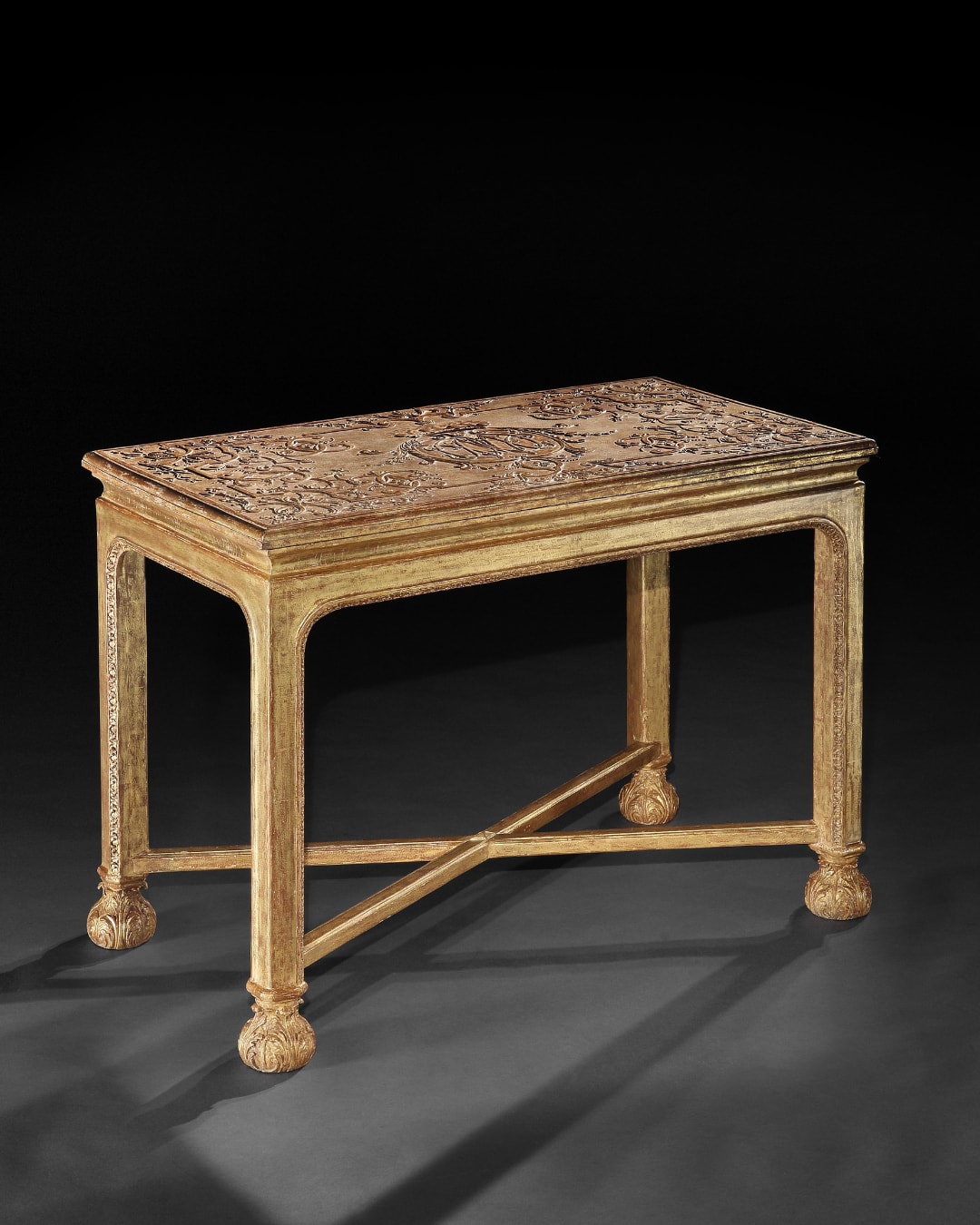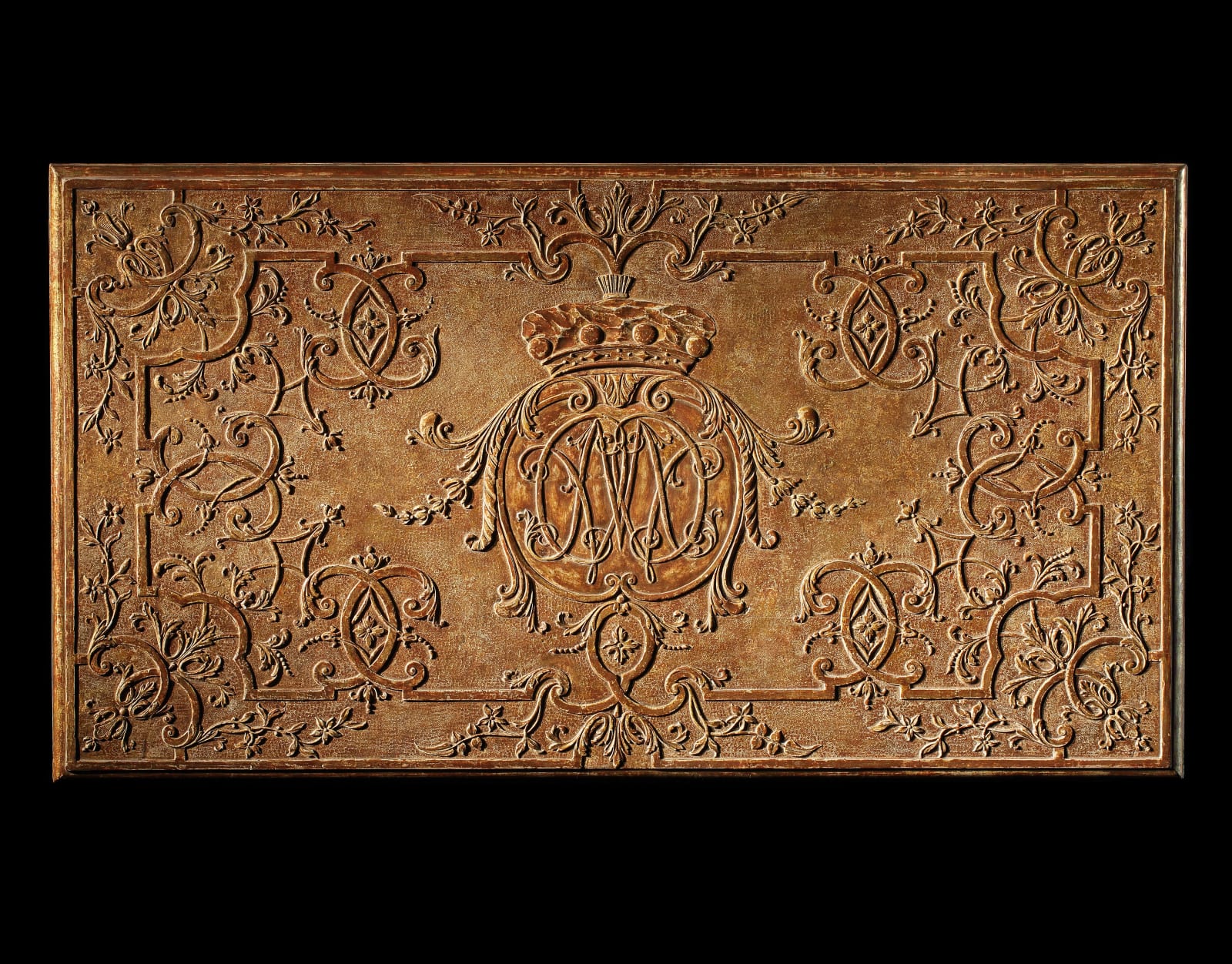THE CADOGAN GESSO TABLE, English, between 1716 and1718
Width: 39 ½ in; 100 cm
Depth: 21 ¾ in; 55 cm
A George I gesso side table attributed to James Moore.
Note: The table retains most of the original gilding.
Giltwood and gesso furniture became fashionable throughout the courts of Europe following its use by Louis XIV of France in the lavish decoration of his new palace at Versailles.
Gesso tables were never intended to be functional pieces of furniture. The extremely delicate table tops were made only to be admired, not to be used. These tables were therefore purely status symbols, conceived in the latest style, to proclaim the wealth and importance of the owner. This table is no exception.
James Moore (1670-1726), who was one of the best known cabinet-makers of the time held a Royal Warrant, signed some of these pieces in the gesso, thus providing the means of direct comparison.
The style of the straight, square legs with carved bulbous toes and of the cross stretcher place the table’s date of manufacture no earlier than 1705 (before this, table legs would be heavily decorated and carved in figural forms) and no later than 1720-1725, when cabriole legs and lion paw feet became fashionable.
The table top is incised with the baron's monogram CWMC. George I raised a number of his favoured subjects to the rank of baron, but only the barony of Cadogan matches these letters, for William Cadogan, Baron Cadogan, and his wife Margaret. The table is likely to have been ordered from Moore to celebrate Cadogan’s elevation to the peerage on 21 June 1716, when he was made Baron Cadogan of reading. Two years later, in 1718, he was created 1st Earl Cadogan of Oakley, making the baron’s coronet in the table top out of date, but placing the date of manufacture precisely between 1716 and 1718, and most probably in 1716.
A comparable table in the Royal Collection at Windsor Castle and bearing the monogram of George I is incised ‘Moore’ into the strapwork at the back of the top. The entwined leaves and flowers carved into the outer border of the top are strikingly similar on both tables.
A gesso table attributable to Moore, of similar form and also with X cross stretcher, was recorded at Windsor Castle in the Rubens Room in 1927. Another table, also featuring straight, square legs, but highly ornamented, was advertised by Edwin H. Herzog Antiques Ltd., London, in 1970. A table in the collection of the Duke of Buccleuch and Queensberry at Boughton House, Northamptonshire, features plain square legs, X cross stretcher and very similar leaf carved ball feet.
Blenheim Palace in Oxfordshire, which was built between 1705 and 1722 for John Churchill, 1st Duke of Marlborough, features many pieces by James Moore. Sarah, Duchess of Marlborough, sought Moore’s help in a dispute about the quality of workmanship at Blenheim Palace. As a result, the architect John Vanbrugh was dismissed and Moore was given control of the building works. Moore then supplied much furniture to the house, and some pieces remain at Blenheim today.
The Duke of Marlborough was largely on campaign overseas in the Spanish War of Succession while Blenheim was being built, and at his side was his close friend and ally William, Baron Cadogan. It is easy to understand why Cadogan would have engaged James Moore for his table, and Moore may well have been recommended by Marlborough himself.
Provenance
William Cadogan, Baron Cadogan of Reading until 1718, and then 1st Earl Cadogan of Oakley, Caversham Park, Berkshire, England;
Private collection, England.
Literature
E. F. Strange, 'Furniture at Windsor Castle', Old Furniture, June 1927, p. 16.
Ralph Edwards and Margaret Jourdain, Georgian Cabinet Makers, 3rd revised edition, 1955, figs 24 & 33.
Country Life, 23 September 1970, supplement 12; advertisement with Edwin H. Herzog Antiques Ltd., London, England.
Christopher Gilbert, A Pictorial Dictionary of Marked London Furniture 1700-1840, 1996, pp. 339-42.
Tessa Murdoch, ‘The King’s cabinet-maker: The giltwood furniture of James Moore the Elder’, Burlington magazine, June 2003, pp. 408-20.




